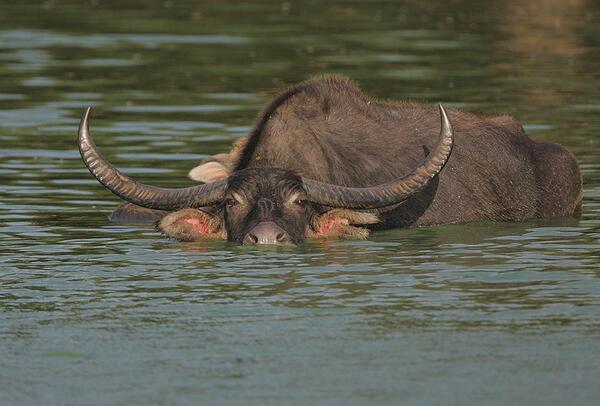Water buffaloes (Bubalus bubalis) are large, domesticated mammals native to Asia and widely known for their remarkable ability to thrive in water-rich environments. They are often seen wallowing in rivers, ponds, and wetlands. However, a common question that arises among curious observers is, how long can a water buffalo hold its breath underwater? This article delves into the physiology and behaviors of water buffaloes, exploring their natural adaptations, diving abilities, and how long they can hold their breath when submerged.

Water buffaloes are well-adapted to their aquatic habitats, exhibiting several physiological traits that enable them to comfortably live and forage in water. Despite their size and weight, water buffaloes are capable swimmers and are often seen submerged or partially submerged in water for extended periods.
Water buffaloes, like other large mammals, have a relatively large lung capacity, which aids in their ability to hold their breath underwater. Although water buffaloes do not actively dive to great depths like some aquatic mammals (e.g., dolphins or whales), they are capable of submerging themselves for brief periods while searching for food or cooling off in hot weather.
Breath-holding Capacity: A typical water buffalo can hold its breath for approximately 1 to 2 minutes underwater. This time frame is sufficient for them to submerge their heads and necks to graze on aquatic vegetation, drink water, or simply cool their bodies in hot climates.
Breathing Efficiency: Water buffaloes do not have a specialized diving mechanism like marine mammals, but their ability to regulate breathing efficiently allows them to stay underwater for short periods without causing harm.
Water buffaloes’ ability to stay submerged is also aided by their natural buoyancy. Their buoyant bodies make it easier for them to remain in shallow water or semi-submerged conditions without expending excessive energy. While submerged, they typically float or slowly move through the water, using minimal energy to maintain their position. This buoyancy assists in conserving oxygen during brief periods of breath-holding underwater.
Water buffaloes are often associated with wetland environments, such as riverbanks, marshes, and rice paddies. Their affinity for water is not just for comfort but also plays a role in their behavioral and ecological adaptations. Being near water helps them regulate body temperature, avoid heat stress, and feed on aquatic plants.
Water buffaloes use water bodies to regulate their body temperature. Wallowing in water helps keep their body cool during hot weather, which is essential for their survival in tropical and subtropical climates. The ability to stay submerged also helps them avoid insects like ticks and flies, providing both a physical and behavioral adaptation to their environment.
Water buffaloes often feed on aquatic plants, such as grasses, reeds, and algae, which can be found along riverbanks and in shallow water. When they feed, they often submerge their heads and use their strong, muscular tongues to pull vegetation out of the water. This behavior, coupled with their breath-holding ability, allows them to feed in aquatic habitats that other grazing animals might find difficult to access.
While water buffaloes can hold their breath underwater for short periods, they differ significantly from other aquatic mammals like dolphins, whales, and otters. These animals have evolved specialized adaptations, including larger lung capacities and more efficient oxygen utilization, enabling them to dive for much longer durations.
Marine Mammals: Species such as dolphins can hold their breath for up to 15 to 20 minutes underwater due to their efficient oxygen storage systems, which allow them to dive to significant depths and remain submerged.
Water Buffaloes: In contrast, water buffaloes are not adapted for prolonged dives. They primarily use water for cooling and grazing rather than for deep dives. Their breath-holding capacity is limited, making them more reliant on shallow waters for their survival and feeding.
| Animal | Breath-Holding Capacity | Primary Function | Adaptations for Breath Control |
|---|---|---|---|
| Water Buffalo | 1 to 2 minutes | Feeding, cooling, and grazing in shallow waters | Large lung capacity, buoyancy, and efficient breathing |
| Dolphins | 15 to 20 minutes | Deep diving for food, communication, and navigation | Specialized lung adaptations, increased oxygen storage |
| Whales | 20 to 90 minutes (depending on species) | Deep diving for food and survival | High oxygen storage, slow metabolism, efficient lungs |
| Otters | 4 to 8 minutes | Hunting for fish and invertebrates underwater | High lung capacity, efficient oxygen use |
| Humans (trained divers) | 3 to 5 minutes (untrained), up to 10 minutes (trained) | Scuba diving, freediving | Special training to increase breath-holding capacity |
This table summarizes the breath-holding capacities of water buffaloes compared to other animals, illustrating the range of abilities across species and highlighting the unique adaptations of each.
In conclusion, water buffaloes are adapted to spend time in water, but their breath-holding capacity is limited. They can remain submerged for up to 1 to 2 minutes, primarily for feeding or cooling off. This brief period of submersion is a result of their lung capacity, buoyancy, and overall behavioral adaptations that help them thrive in water-rich environments. While they are excellent swimmers, their abilities are not comparable to those of specialized aquatic mammals, which can hold their breath for much longer.
animal tags: Bovidae
We created this article in conjunction with AI technology, then made sure it was fact-checked and edited by a Animals Top editor.